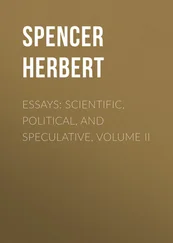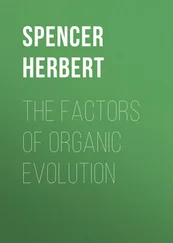The principle thus displayed in the humbler forms of life, is traceable during the development of the higher; though being here soon masked by the assumption of the hereditary type, it cannot be traced far. Thus the "mulberry-mass" into which a fertilized ovum of a vertebrate animal first resolves itself, soon begins to exhibit a difference between the outer and inner parts answering to the difference of circumstances. The peripheral cells, after reaching a more complete development than the central ones, coalesce into a membrane enclosing the rest; and then the cells lying next to these outer ones become aggregated with them, and increase the thickness of the germinal membrane, while the central cells liquefy. Again, one part of the germinal membrane presently becomes distinguishable as the germinal spot; and without asserting that the cause of this is to be found in the unlike relations which the respective parts of the germinal membrane bear to environing influences, it is clear that we have in these unlike relations an element of disturbance tending to destroy the original homogeneity of the germinal membrane. Further, the germinal membrane by and by divides into two layers, internal and external; the one in contact with the liquefied interior part or yelk, the other exposed to the surrounding fluids: this contrast of circumstances being in obvious correspondence with the contrast of structures which follows it. Once more, the subsequent appearance of the vascular layer between these mucous and serous layers, as they have been named, admits of a like interpretation. And in this and the various complications which now begin to show themselves, we may see coming into play that general law of the multiplication of effects flowing from one cause, to which the increase of heterogeneity was elsewhere ascribed. [9]
Confining our remarks, as we do, to the most general facts of development, we think that some light is thus thrown on them. That the unstable equilibrium of a homogeneous germ must be destroyed by the unlike exposure of its several units to surrounding influences, is an a priori conclusion. And it seems also to be an a priori conclusion, that the several units thus differently acted upon, must either be decomposed, or must undergo such modifications of nature as may enable them to live in the respective circumstances they are thrown into: in other words— they must either die or become adapted to their conditions . Indeed, we might infer as much without going through the foregoing train of reasoning. The superficial organic units (be they the outer cells of a "mulberry-mass," or be they the outer molecules of an individual cell) must assume the function which their position necessitates; and assuming this function, must acquire such character as performance of it involves. The layer of organic units lying in contact with the yelk must be those through which the yelk is absorbed; and so must be adapted to the absorbent office. On this condition only does the process of organization appear possible. We might almost say that just as some race of animals, which multiplies and spreads into divers regions of the earth, becomes differentiated into several races through the adaptation of each to its conditions of life; so, the originally homogeneous population of cells arising in a fertilized germ-cell, becomes divided into several populations of cells that grow unlike in virtue of the unlikeness of their circumstances.
Moreover, it is to be remarked in further proof of our position, that it finds its clearest and most abundant illustrations where the conditions of the case are the simplest and most general—where the phenomena are the least involved: we mean in the production of individual cells. The structures which presently arise round nuclei in a blastema, and which have in some way been determined by those nuclei as centres of influence, evidently conform to the law; for the parts of the blastema in contact with the nuclei are differently conditioned from the parts not in contact with them. Again, the formation of a membrane round each of the masses of granules into which the endochrome of an alga-cell breaks up, is an instance of analogous kind. And should the recently-asserted fact that cells may arise round vacuoles in a mass of organizable substance, be confirmed, another good example will be furnished; for such portions of substance as bound these vacant spaces are subject to influences unlike those to which other portions of the substance are subject. If then we can most clearly trace this law of modification in these primordial processes, as well as in those more complex but analogous ones exhibited in the early changes of an ovum, we have strong reason for thinking that the law is fundamental.
But, as already more than once hinted, this principle, understood in the simple form here presented, supplies no key to the detailed phenomena of organic development. It fails entirely to explain generic and specific peculiarities; and leaves us equally in the dark respecting those more important distinctions by which families and orders are marked out. Why two ova, similarly exposed in the same pool, should become the one a fish, and the other a reptile, it cannot tell us. That from two different eggs placed under the same hen, should respectively come forth a duckling and a chicken, is a fact not to be accounted for on the hypothesis above developed. Here we are obliged to fall back upon the unexplained principle of hereditary transmission. The capacity possessed by an unorganized germ of unfolding into a complex adult which repeats ancestral traits in minute details, and that even when it has been placed in conditions unlike those of its ancestors, is a capacity impossible for us to understand. That a microscopic portion of seemingly structureless matter should embody an influence of such kind, that the resulting man will in fifty years after become gouty or insane, is a truth which would be incredible were it not daily illustrated. But though the manner in which hereditary likeness, in all its complications, is conveyed, is a mystery passing comprehension, it is quite conceivable that it is conveyed in subordination to the law of adaptation above explained; and we are not without reasons for thinking that it is so. Various facts show that acquired peculiarities resulting from the adaptation of constitution to conditions, are transmissible to offspring. Such acquired peculiarities consist of differences of structure or composition in one or more of the tissues. That is to say, of the aggregate of similar organic units composing a germ, the group going to the formation of a particular tissue, will take on the special character which the adaptation of that tissue to new circumstances had produced in the parents. We know this to be a general law of organic modifications. Further, it is the only law of organic modifications of which we have any evidence. [10]It is not impossible then that it is the universal law; comprehending not simply those minor modifications which offspring inherit from recent ancestry, but comprehending also those larger modifications distinctive of species, genus, order, class, which they inherit from antecedent races of organisms. And thus it may be that the law of adaptation is the sole law; presiding not only over the differentiation of any race of organisms into several races, but also over the differentiation of the race of organic units composing a germ, into the many races of organic units composing an adult. So understood, the process gone through by every unfolding organism will consist, partly in the direct adaptation of its elements to their several circumstances, and partly in the assumption of characters resulting from analogous adaptations of the elements of all ancestral organisms.
But our argument does not commit us to any such far-reaching speculation as this; which we introduce simply as suggested by it, not involved. All we are here concerned to show, is, that the deductive method aids us in interpreting some of the more general phenomena of development. That all homogeneous aggregates are in unstable equilibrium is a universal truth, from which is deducible the instability of every organic germ. From the known sensitiveness of organic compounds to chemical, thermal, and other disturbing forces, we further infer the unusual instability of every organic germ—a proneness far beyond that of other homogeneous aggregates to lapse into a heterogeneous state. By the same line of reasoning we are led to the additional inference, that the first divisions into which a germ resolves itself, being severally in a state of unstable equilibrium, are similarly prone to undergo further changes; and so on continuously. Moreover, we have found it to be equally an a priori conclusion, that as, in all other cases, the loss of homogeneity is due to the different degrees and kinds of force brought to bear on the different parts; so, in this case too, difference of circumstances is the primary cause of differentiation. Add to which, that as the several changes undergone by the respective parts thus diversely acted upon, are changes which do not destroy their vital activity, they must be changes which bring that vital activity into subordination to the incident forces—they must be adaptations; and the like must be in some sense true of all the subsequent changes. Thus by deductive reasoning we get some insight into the method of organization. However unable we are, and probably ever shall be, to comprehend the way in which a germ is made to take on the special form of its race, we may yet comprehend the general principles which regulate its first modifications; and, remembering the unity of plan so conspicuous throughout nature, we may suspect that these principles are in some way concerned in succeeding modifications.
Читать дальше












